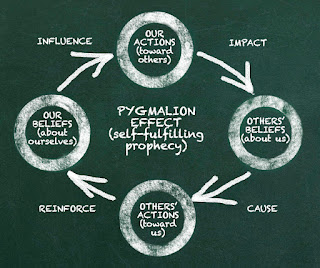In this post I'm going to comment the following vídeo about Pygmalion's Effect:
In the video, we can see this effect through an experiment. In this experiment, the teachers put in a hat the names of students; and then they have to take out some ballots. Finally, the teacher will talk about these students positively or negatively. And, as we have seen, these perceptions about students affect when working with them.
The video begins by
explaining, at a general level, what is meant by Pygmalion's effect: one of the
events that describes the belief that one person has to be able to influence
the performance of another.
In the video, we can see this effect through an experiment. In this experiment, the teachers put in a hat the names of students; and then they have to take out some ballots. Finally, the teacher will talk about these students positively or negatively. And, as we have seen, these perceptions about students affect when working with them.
As a conclusion of this
experiment, we have seen that it has both positive and negative effects:
On the one hand, as a
positive aspect, teachers who have positive prejudices about these students, facilitate
the teaching-learning process, pay more attention to them, help them more, have
them more controlled and pay much more attention to them.
On the other hand, as a negative aspect, the teachers who have worse prejudices about these students, they pay less attention to them, they spend more of them, they do not pay much attention and they do not get so involved in their teaching-learning process
As a personal opinion, I think that this effect is closely linked to prejudice. First of all, obviously I think that the prejudices that a person tells you about another will influence your relationship with that person and that you will see him in a very different way than if he had not told you anything about her.
And also I make it
clear that, as teachers, we should leave prejudices aside and know how they
really are, focus on knowing them and get the best out of them without making
extinctions.

Comentarios
Publicar un comentario